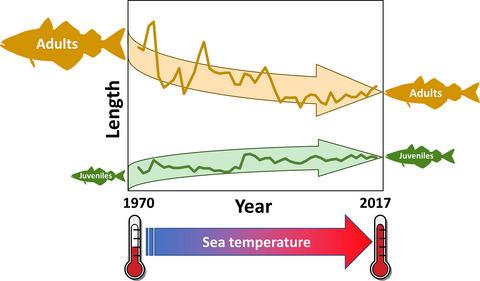当前位置:
X-MOL 学术
›
J. Appl. Ecol.
›
论文详情
Our official English website, www.x-mol.net, welcomes your feedback! (Note: you will need to create a separate account there.)
Bigger juveniles and smaller adults: Changes in fish size correlate with warming seas
Journal of Applied Ecology ( IF 5.7 ) Pub Date : 2020-12-15 , DOI: 10.1111/1365-2664.13807 Idongesit E. Ikpewe 1 , Alan R. Baudron 1 , Aurore Ponchon 1 , Paul G. Fernandes 1
中文翻译:

较大的少年和较小的成年人:鱼的大小变化与海洋变暖有关
更新日期:2020-12-15
Journal of Applied Ecology ( IF 5.7 ) Pub Date : 2020-12-15 , DOI: 10.1111/1365-2664.13807 Idongesit E. Ikpewe 1 , Alan R. Baudron 1 , Aurore Ponchon 1 , Paul G. Fernandes 1
Affiliation

|
- Increasing sea temperatures are predicted to decrease body size of marine ectotherms based on the temperature size rule. This will impact fisheries yields, but empirical evidence of the process is still limited.
- We used fishery‐independent bottom trawl survey data from 1970 to 2017 to examine the trends of length‐at‐age of four commercially important demersal fish species (cod, haddock, whiting and saithe) in two study areas facing increasing sea temperatures: the West of Scotland and the North Sea. We then compared the trends of length‐at‐age with annual bottom sea temperatures.
- The mean length‐at‐age of adults declined over the study period, in all species and in both areas, except for cod in the West of Scotland. A common trend of decline in adult length was inversely correlated with bottom sea temperatures. Correlations with temperature at seven yearly time‐lags were significant and negative in the North Sea. Correlations were only significant at lags of 1 and 2 years in the west of Scotland, where sea temperature warming was twice as slow.
- The mean length‐at‐age of juveniles concurrently increased, which has not hitherto been reported. This trend, shared by all species and both regions, correlated positively with rising temperature, suggesting that our study species have a faster growth rate due to increased temperatures.
- Synthesis and applications. We examined the body size of a range of commercially exploited fish species, at different age groups, from two management regions. We found that juvenile fish have been getting bigger and adults smaller in both regions. These changes were correlated with rising sea temperatures, providing empirical evidence that global warming is affecting the size of commercial fish species. The effects of these changes on productivity of fish populations and fisheries yield now require investigation. Temperature changes should, therefore, be included into forecasts used in fisheries science in order to mitigate the impact of global warming and maximise sustainable yields.
中文翻译:

较大的少年和较小的成年人:鱼的大小变化与海洋变暖有关
- 根据温度大小规则,预测海水温度升高会减小海洋等温线的体型。这将影响渔业产量,但是该过程的经验证据仍然有限。
- 我们使用了1970年至2017年与渔业无关的海底拖网调查数据,研究了两个面临海洋温度升高的研究区域中四种商业上重要的沉水鱼类(鳕鱼,黑线鳕,鳕鱼和赛艇)的年龄长短趋势。苏格兰和北海。然后,我们比较了平均年龄与年底海底温度的趋势。
- 在研究期内,除苏格兰西部的鳕鱼外,所有物种和两个地区的成年成年人平均身高均下降。成人体长下降的常见趋势与海底温度成反比。在北海,七个时滞的温度相关性是显着的,并且是负相关的。相关性仅在苏格兰西部滞后1年和2年时才显着,那里的海水温度变暖是缓慢的两倍。
- 同时,未成年人的平均身高有所增加,迄今尚未见报道。所有物种和两个地区共有的这一趋势与温度升高呈正相关,这表明我们的研究物种由于温度升高而具有更快的生长速度。
- 综合与应用。我们检查了来自两个管理区域的不同年龄组的一系列商业开发鱼类的体型。我们发现在这两个区域中,幼鱼的体积越来越大,成鱼的体积越来越小。这些变化与海水温度升高有关,提供了经验证据表明全球变暖正在影响商品鱼的规模。这些变化对鱼类种群生产力和渔业产量的影响现在需要调查。因此,温度变化应纳入渔业科学预测中,以减轻全球变暖的影响并最大程度地提高可持续产量。



























 京公网安备 11010802027423号
京公网安备 11010802027423号